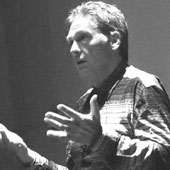 Barley Field, with permission from Shutterstock
Barley Field, with permission from Shutterstock
4baq: In your opinion, what is the position of design in “development?"
John Thackara: The word development is often used to imply that advanced people in rich countries must help backward people in poorer countries "catch up." It's in this spirit that many designers donate their time and expertise to projects such as $100 laptops, emergency shelter and mobile hospitals. But consider this: the average US citizen emits as much CO2 in one day as someone in China does over a week, or a Tanzanian in seven months. A tourist from a rich country can uses as much water in 24 hours as a native villager uses in 100 days. The word "development" does not make perfect sense.
4baq: How do you think design can create sustainable development?
JT: Many of the troubling situations in our world are the result of design decisions. The parlous condition of the planet, our only home, is a good example. Eighty percent of the environmental impact of the products, service, and infrastructures around us is determined at the design stage. Design decisions shape the processes behind the products we use, the materials and energy required to make them, the ways we operate them on a daily basis and what happens to them when we no longer need them. We may not have meant to do so and we may regret the way things have turned out, but we designed our way into the situations that face us today. The premise of Plan B is simply stated: if we can design our way into difficulty, we can design our way out.
4baq: In today’s world how is sustainable design influenced by local cultures?
JT: A key feature of sustainability is the relocalization of economic activity. Authenticity, local context and local production are increasingly desirable attributes in the things we buy and the services we use. The term “territorial capital” is now being used to explore the “hard” and “soft” assets of a region. This kind of capital includes natural beauty and features, cultural festivals, unique skills, social ties, civic loyalty and memories. Because these kinds of assets are not commonly found in over-designed mono-cultures, place designers and urban planners now have to pay as much attention to social networks and soft infrastructure as they do to the hard infrastructures of roads and railways.
The design lesson is this: we need to look in new places for inspiration, and cultivate the habit of looking for people, places, organizations, projects and ideas that do not appear on the radar screens used by conventional design and innovation.
4baq: Sustainability, design and development, are vertices of a triangle. What is the output of this triangle?
JT: Traditional design thinking focuses on form and structure. Problems are “decomposed” into smaller steps, and these are prioritized in lists. Actions and inputs are described in a blueprint or plan while other people produce or implement it. This is a top-down, outside-in approach. It doesn’t work well now because complex systems, especially human-centered ones, won’t sit still while we re-design them. A sense-and-respond kind of design works better: Desired outcomes are described, but not the detailed means of getting to those outcomes.
4baq: What are indexes of sustainable products?
JT: Wikipedia defines our destination, sustainability, as "a characteristic of a process or state that can be maintained at a certain level indefinitely." That's not where we are now. The inputs and outputs of industrial society are wildly out of balance. Our economy has become over-complex and depends on excessive flows of non-renewable energy and matter.
Sustainability is not some distant, hard-to-reach goal — it's already emerging. Many of the elements of a sustainable world already exist, such as technological solutions. Other solutions are to be found in the natural world, thanks to millions of years of natural evolution. The majority of solutions are social practices — some of which are very old and have evolved in other societies through time.
This interview was originally published on 4baq, September 23, 2009.

